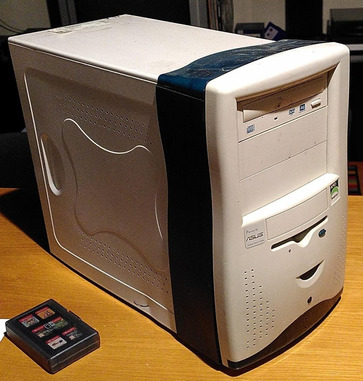1995-2005 is exactly the period that hardware and software advanced at its fastest. These days you could easily run all 10-year old software on a current machine, and with some compromises in settings you could run the vast majority of current software on a 10-year old one (yes, for Windows 11 you need to hack the TPM2.0 requirement, but that's about security, not performance), at least assuming RAM had been upgraded at some time. Let's try that with 1995 and 2005...
A 2005 system will be based on a late Pentium 4 or early Athlon64, with AGP (or even very early PCI Express) and PCI - and no ISA. It will have at least 512MB RAM, probably two or four times that. It wil run Windows XP, although Windows 98SE might still run on it - if you can find drivers for the hardware.
Now a 1995 system. Most likely it will still be a 486DX4, although it might (if you were rich) be an early Pentium. It will have ISA slots and PCI and/or VLB. No AGP let alone PCIe. It will come with 8MB RAM or 16MB if splurging. It will run MS DOS which may have Windows 3.11 as a GUI on top of it. WIndows 95 wasn't released until the end of the year and at release it was slow and buggy.
Windows XP needs at least 64MB as absolute minimum, although without service packs you needed 192MB for it to be usable, and by SP2 (what you would/should have been running in 2005) 512MB would be recommended and 1GB or more needed for a smooth experience. It would run on any Pentium CPU but not a 486. So unless you had a Pentium in 1995 and you upgraded it insanely to 64MB XP wouldn't even boot, and if it did, you could make a cup of coffee before you had a user interface, let alone were able to start a program. Forget gaming.
The other way round is only marginally better. DOS supports max 64MB RAM, which is vastly less than the smallest DIMM you could put in a 2005 system. In fact >16MB expect to have memory detection issues giving you 'out of memory' errors despite vast amounts free. This can be solved by limiting memory in CONFIG.SYS. Other challenges are bigger. DOS isn't really a full operating system that abstracts access to hardware. Apart from a number of standard calls, DOS software talks directly to hardware and does so assuming it's talking to an ISA bus. When gaming, this means that sound is a big challenge. There are no such things as 'drivers'. Games talk directly to sound cards (which is why 1990s sound cards needed hardware compatibility with things like AdLib and Sound Blaster) and does so at a specific I/O address using specific IRQ and DMA. This works fine with ISA, but is essentially incompatible with PCI. If you don't have an ISA bus, you need to try to emulate one over PCI. That can be done, but always involves compromises and where early PCI systems had a lot of workarounds for this, by 2005 such workarounds were rare and you have few choices and even they come with limitations that mean some things just won't work. And then there's speed. A lot of DOS games, particularly early or very demanding ones, were coded to use all the processing power available. That meant that your game would run better if you upgraded a little bit. But if you try to run a non-limited game designed for a Pentium 100 on a 3GHz Pentium 4, it will be utterly unplayable. Again, there are workarounds, but they have limits and don't always work.
Now, with some very special hardware you can solve some of this, but it will involve excessive cost, effort and will hardly resemble what you had back then. I'm talking about industrial systems with new(er) CPUs combined with PCI to ISA bridges, designed to allow (very) old industrial systems with proprietary ISA controllers to keep working if the ancient hardware controlling it dies and cannot be replaced anymore. These things exist, but are expensive. Also, they usually only feature PCI and ISA expension (using PICMG 1.1) and have video onboard, which will rarely be sufficient to play 2005 games. Now there also exist ATX motherboards with ISA bridges that still do have AGP/PCIe slots, but they are even rarer and more expensive. And you still have the speed issues and memory issues...
TLDR: keep it simple (and cheap), split this into a DOS system with ISA slots and CPU that is fast enough but not too fast and can be slowed down as needed (eg Via C3 for So370 or - more expensive - K6-2+ for Socket 7) and ISA sound cards (big, big rabbit hole to go down there if you want - remember, games talk directly to hardware, so different hardware can sound very different), and a WindowsXP system that can run 98SE if needed, with a 2005 CPU and nice beefy AGP card and 3D audio PCI sound card.
DOSbox is also great, although I'd just run that on whatever current system you have rather than on a legacy system. It might be a bit slow on a 2005 CPU.

